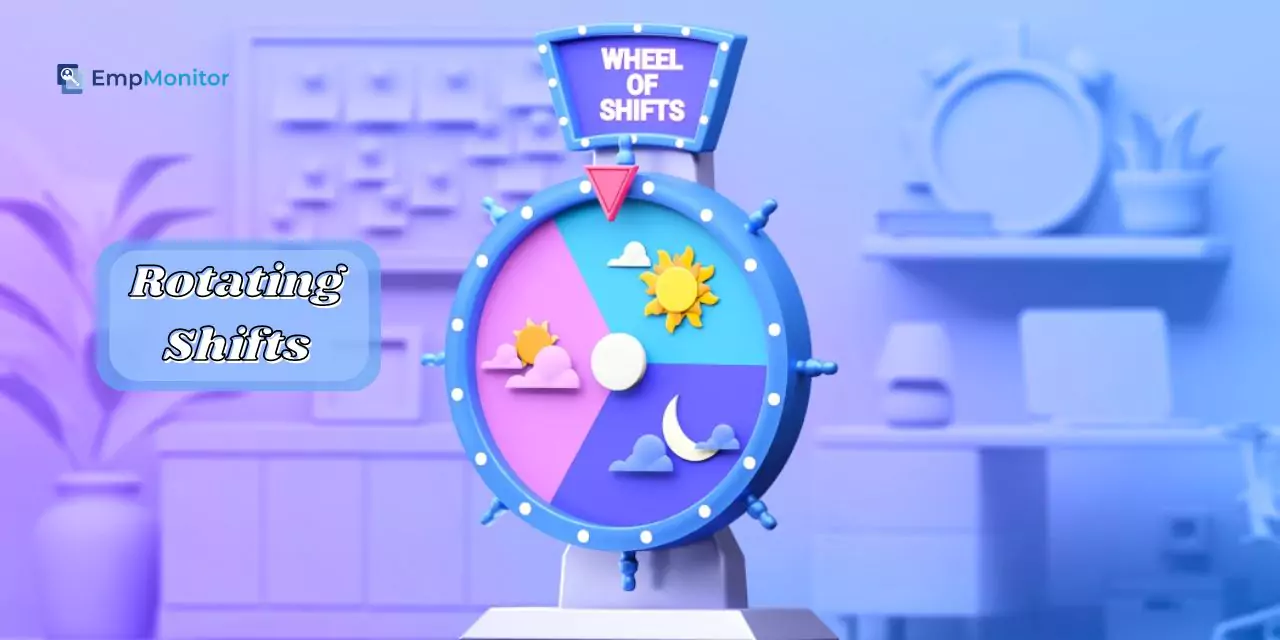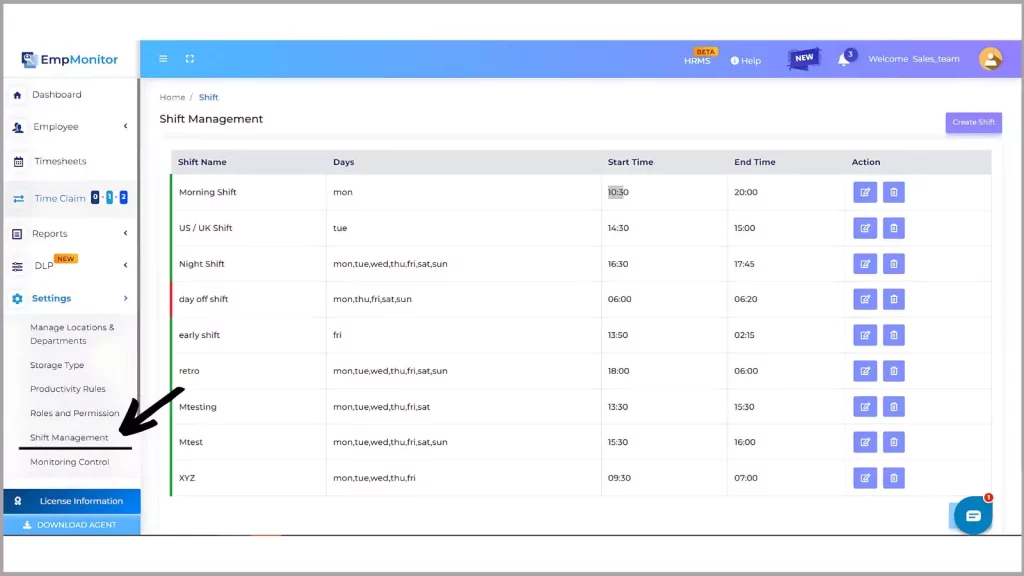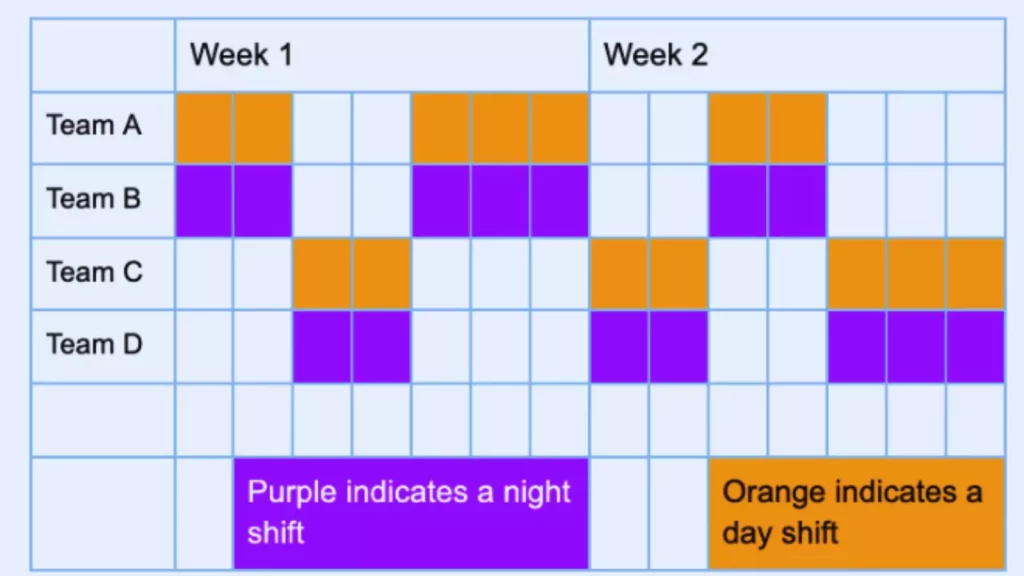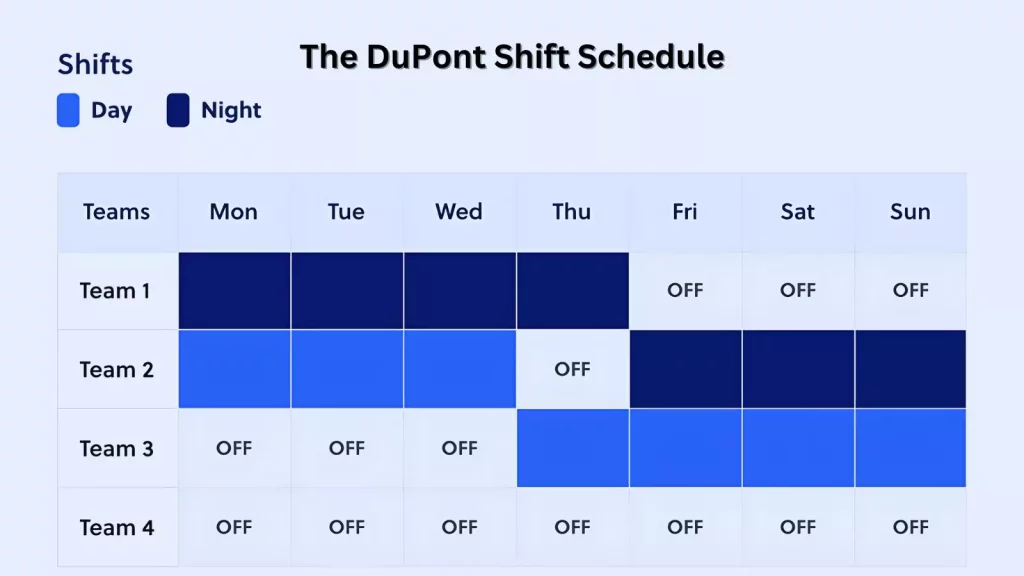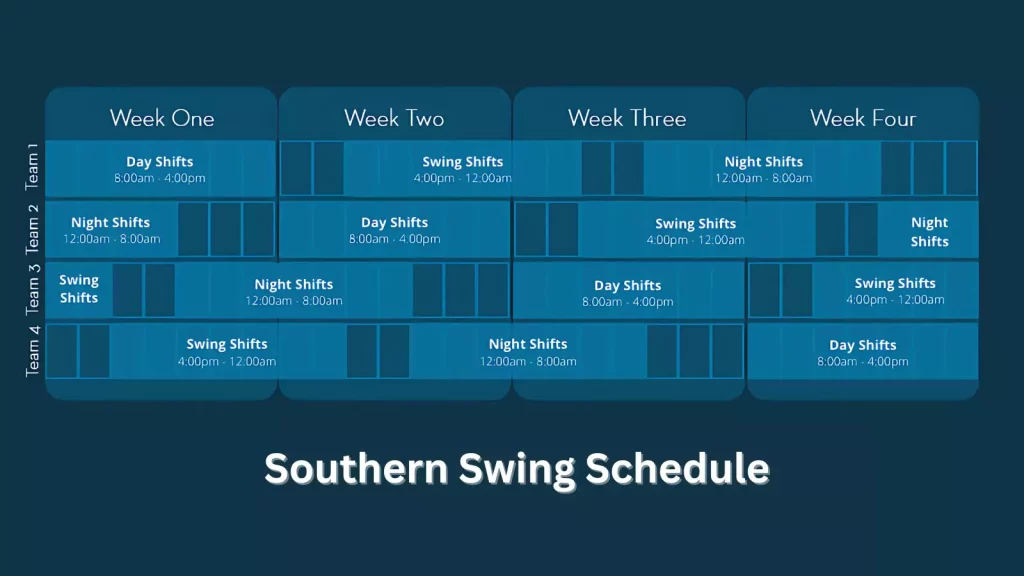Many businesses need staff outside the typical 9-to-5 hours. Whether in healthcare, manufacturing, hospitality, or other industries, rotating shifts have become a cornerstone of modern work schedules.
However, this shift is based on employees working different shifts across 24 hours or varying schedules from week to week, bringing unique challenges and opportunities.
Navigating rotating shifts requires more than adjusting sleep patterns; it demands a strategic approach to maintain productivity, ensure employee well-being, and optimize operational efficiency.
In this blog, we delve into the intricacies of shift rotation- exploring its benefits, potential drawbacks, and practical strategies for employers and employees to thrive in this dynamic work environment.
HIT THE PLAY BUTTON TO LISTEN TO THE PODCAST:
What Are Rotating Shifts?
Rotating shifts involves alternating work schedules where employees switch between different shifts periodically. This arrangement ensures coverage across various times, such as day, night, and swing shifts, typically in businesses operating extended hours or around the clock.
But what are swing shifts, and how are they different from rotating shifts? Let’s find out!
Swing Shift Vs. Rotating Shift
Swing shift means workers are assigned to cover both day and night shifts. Additionally, there are often employees designated to fill in during the transitional hours between these shifts or to provide extra support during peak periods of activity. This setup ensures that the workplace is adequately staffed throughout the day and night, accommodating varying operational demands.
On the other hand, rotating shifts operate on a schedule such as a 2-2-3 format, where employees rotate through both day and night shifts within a structured timeframe, typically spanning 14 or 28 days. This rotational system ensures that each worker has an equal opportunity to work during both day and night shifts for the rotation. Shift lengths in rotating schedules often range between 8 to 12 hours per shift.
Swing shifts focus on covering specific transitional or peak hours between day and night shifts with fixed assignments- while shift rotation distributes work hours more evenly across day and night shifts through a rotating schedule format. Each approach offers distinct advantages depending on the operational needs and preferences of the organization and its employees.
How Does Rotating Shifts Work?
Rotating shifts ensures that employees have the opportunity to work every shift within a schedule without fixed assignments.
For example, in a business operating with three shifts (day shift from 7 am to 3 pm, evening shift from 3 pm to 11 pm, and night shift from 11 pm to 7 am), employees are organized into teams. These teams rotate through shifts on a daily, weekly, or monthly basis:
- Daily Shifts: Team 1 rotates through day shifts, evening shifts, and night shifts daily.
- Weekly Shifts: Team 1 works day shifts for one week, then switches to evening shifts the following week and night shifts the week after that. Teams 2 and 3 alternate shifts similarly.
- Monthly Shifts: Team 1 works day shifts for one month, evening shifts for the next month, and night shifts for the third month. Teams 2 and 3 rotate through the remaining shifts over their respective three-month periods.
These rotating schedules ensure that each team and employee experiences all shifts equally, promoting operational continuity and fairness in work distribution.
The Pros of Rotating Shifts
Rotating shifts offer several key benefits for both employees and employers:
Enhanced Workforce Flexibility: It provides increased flexibility by allowing employees to work at different times of the day or night. This flexibility accommodates personal commitments, such as caregiving or education, and helps businesses meet fluctuating customer demands during peak hours.
Improved Employee Coverage: Companies ensure continuous coverage throughout the day and night. It ensures that employees- are available to handle tasks, serve customers, and respond to emergencies, crucial in sectors like healthcare, manufacturing, and customer service.
Diverse Job Experiences: It exposes employees to various aspects of their roles, fostering skill development and job satisfaction. Employees gain experience in different tasks and interact with diverse colleagues, preventing monotony and enhancing engagement at work.
Potential for Reduced Burnout: It can potentially mitigate burnout by distributing work hours across different days and times. This approach helps prevent employees from consistently working long hours, reducing stress and improving overall work-life balance and well-being.
Effectively managing rotating shifts is essential to capitalize on these benefits and address related challenges proactively.
The Cons of Rotating Shifts
It brings several challenges that organizations need to address:
Complex Scheduling- Creating rotating schedules is difficult due to the need to accommodate diverse employee preferences and operational requirements. Balancing factors like availability, seniority, and skill sets complicates the scheduling process, increasing administrative workload and potentially affecting employee satisfaction and productivity.
Communication Disruptions- Working on different schedules can hinder communication and collaboration among team members. Misunderstandings and missed meetings may occur, impacting teamwork and information sharing crucial for effective work outcomes.
Impact on Work-Life Balance- Rotating shifts can disrupt work-life balance by making it challenging for employees to plan personal activities and spend time with family. The unpredictable schedule can cause stress and dissatisfaction, affecting overall well-being.
Policy Complexity- Designing customizable shift-related policies is complex, considering factors like employee availability, job roles, and legal regulations. Customizing policies to meet departmental or team-specific needs while aligning with organizational standards requires careful workforce management to maintain a harmonious work environment.
Addressing these challenges effectively for streamlined shift management and implementing policies that balance flexibility with operational needs to support employee well-being and organizational productivity.
Tips For Rotating Shifts
Here are seven key tips for effectively managing rotating shifts:
1. Sequential Shift Rotation:
Instead of quickly switching from one shift to another (e.g., from evening to day), rotate shifts in a sequence that progresses from day shifts to evening shifts and then to overnight shifts. This gradual rotation helps employees’ bodies and minds adjust more smoothly to changing work schedules over time.
2. Training and Preparation:
Offer training sessions and provide tips to help employees prepare for shift rotation. It could involve guidance on- how to gradually adjust sleep patterns or adopt new routines to align with different shift timings. Proper preparation can reduce the physical and mental impact of shift changes.
3. Shift Preference Accommodation:
Allow employees to indicate their shift preferences. It may not always be possible to accommodate everyone’s preferences due to operational needs, but making a genuine effort to consider and accommodate these requests where feasible can boost morale and job satisfaction.
4. Use of Scheduling Software:
Implementing scheduling software helps in managing shift rotations efficiently. It minimizes scheduling errors such as double-booking employees or leaving shifts understaffed. It ensures that each shift has the appropriate number of employees, enhancing operational efficiency and reducing administrative burden. Employee monitoring tools like EmpMonitor streamline this process.
It specifically aids in this by tracking attendance across all shifts in real-time, providing managers with up-to-date insights into employee availability and performance. This data allows managers to make informed decisions when scheduling shifts, leading to better workforce allocation and improved productivity.
EmpMonitor’s reporting features help analyze historical attendance patterns, enabling proactive adjustments to future schedules to meet operational needs effectively. Overall, EmpMonitor software not only simplifies shift management but also empowers businesses to achieve greater efficiency and employee satisfaction through optimized scheduling practices.
5. Clear Communication:
Maintain transparent communication about schedules and any changes. Provide schedules well in advance and use multiple communication channels (e.g., email, bulletin boards, scheduling apps) to ensure that all employees are informed. Clear communication helps employees plan their personal lives around work commitments effectively.
6. Advance Notice:
Give employees sufficient notice of their schedules. It allows them to plan their activities and commitments outside of work without last-minute disruptions. Providing advanced notice promotes stability and predictability, essential for employee well-being and job satisfaction.
7. Wellness Support:
Offer resources and support for employee wellness. It can include access to mental health services, wellness programs, or resources for stress management and healthy living. Supporting employees’ well-being during shift rotation helps mitigate the challenges associated with irregular schedules and promotes a healthier workforce.
By implementing these strategies and leveraging EmpMonitor software, organizations can effectively manage rotating shifts, enhance employee satisfaction, and maintain productivity and well-being among their workforce.
EmpMonitor: Workforce Management Software
EmpMonitor is a comprehensive employee monitoring and productivity tracking tool designed for businesses to effectively manage their workforce.
It optimizes rotating shift management with real-time monitoring and time-tracking. It ensures compliance, enhances productivity, and fosters efficient operations through detailed reporting and security features.
EmpMonitor offers several key features that cater to the needs of modern workplaces:
- Attendance Tracking: For rotating shifts, accurate attendance tracking is crucial. EmpMonitor records employee clock-ins, clock-outs, and breaks, ensuring that all hours worked are logged correctly regardless of the shift schedule.
- Activity Monitoring: Monitoring employee activities- during different shifts ensures that productivity levels are maintained consistently. EmpMonitor tracks application and website usage, providing insights into how employees spend their time during each shift.
- Remote Monitoring: If some employees work remotely during their shifts, EmpMonitor can monitor their activities securely, providing visibility into their productivity and ensuring accountability regardless of location.
- Reporting and Insights: EmpMonitor provides comprehensive reports and analytics on shift performance, employee attendance, and productivity metrics. These insights enable managers to make data-driven decisions to improve- shift management and overall operational efficiency.
- Shift management: This feature allows businesses to record and customize employee shift details, including names, days, and timings. This flexibility ensures customized management of employee hours to meet specific operational requirements, improving efficiency and organizational effectiveness.
EmpMonitor software supports organizations with shift rotation by providing robust monitoring, tracking, and analytics tools that enhance workforce management and ensure optimal productivity across different shift schedules.
Types Of Rotating Shifts
Human resource professionals have developed several types of rotating schedules over time. Understanding these different approaches can help HR managers choose the most suitable rotation system for their organization.
This familiarity allows them to assess various styles of employee schedules and select the one that aligns best with their operational needs and workforce management strategies.
1. The Pitman Shift Schedule
Also known as a 2-3-2 schedule, employees work 12-hour shifts in a rotation involving four teams. The schedule ensures employees have every other weekend off, allowing time for family and social activities during regular hours. To prevent fatigue, employees typically do not work more than three consecutive days. Here’s an example of the schedule pattern:
- Two shifts followed by two days off
- Two shifts followed by three days off
- Three shifts followed by two days off
After completing this two-week cycle, employees switch to the opposite shift timing (e.g., day shifts to night shifts and vice versa).
2. The DuPont Shift Schedule
The DuPont shift schedule, named after the company that originated it, involves four teams working 12-hour shifts in a rotating pattern over a four-week cycle. Here’s an example of how it operates:
- Four-night shifts followed by three days off
- Three-day shifts followed by one day off
- Three-night shifts followed by three days off
- Four-day shifts followed by seven days off
This schedule provides employees with extended periods of consecutive days off, such as a full week, allowing ample time for rest and personal activities. However, it also involves longer work hours and fewer breaks during some parts of the cycle, which may be demanding for workers. Managers should consider the balance between extended time off and the intensity of the work schedule when implementing the DuPont shift schedule.
3. Southern Swing Schedule
The Southern swing rotation shift schedule employs four teams working three eight-hour shifts over a 28-day cycle. Here’s how the rotation works:
- Seven-day shifts
- Two days off
- Seven swing shifts
- Two days off
- Seven-night shifts
- Three days off
This schedule allows employees to work consistent eight-hour shifts, unlike other rotating shift schedules- that may involve longer shifts of 10 or 12 hours. One of the advantages of the Southern Swing schedule is its structured rotation pattern, which provides regular breaks and predictable shift changes. However, adjusting to working seven consecutive days in a row may require some adaptation for employees.
4. The 2-2-3-2-2-3 shift schedule
The 2-2-3-2-2-3 shift schedule involves rotating 12-hour shifts over a 28-day cycle, organized as follows:
- Three-day shifts
- Two days off
- Two-day shifts
- Three days off
- Two-night shifts
- Two days off
- Three-night shifts
- Two days off
- Two-night shifts
- Three days off
- Two-day shifts
- Two days off
This schedule provides employees with frequent breaks and ensures they never work more than three consecutive days. It also includes a three-day weekend every other weekend. While beneficial for providing extended time off, especially in industries like construction and healthcare, the demanding nature of 12-hour shifts should be considered.
CHECK OUR LATEST POSTS:
How To Create An Effective Work Schedule: 09 Easy Steps
The Need For Contingent Workforce Management To Boost Your Business
How To Manage Swing Shift Hours Effectively?
Conclusion
Implementing a well-structured rotating shift schedule can bring substantial benefits to both employees and employers. By carefully considering the type of rotating shifts that best suit your organization’s needs and taking into account factors such as employee preferences, workload distribution, and productivity patterns, you can foster a more balanced and efficient work environment.
Moreover, leveraging modern time-tracking software like EmpMonitor for employee management can streamline operations and enhance overall workforce satisfaction. Ultimately, a thoughtful approach to rotating shifts not only ensures operational continuity but also fosters a healthier and more productive workplace.
FAQs
1. What is the healthiest rotating shift schedule?
The healthiest rotating shift schedule is one that rotates forward from day to afternoon to night. This approach aligns better with your circadian rhythm, making it easier for your body to adjust compared to shift rotation backward.
2. How can I manage working rotating shifts, including night and day shifts?
Here are some tips to help you manage shift rotation:
- Adjust Your Sleep Schedule: Practice staying up later and sleeping in a few days before your shift to gradually shift your sleep pattern.
- Get Enough Rest: Sleep and nap before your shifts to ensure you are well-rested.
- Eat Well: Maintain a healthy diet and pack nutritious food to keep your energy levels up.
- Stay Alert: Find ways to keep your mind engaged and alert during your shift.
- Limit Caffeine: Avoid relying too much on caffeine as it can disrupt your sleep later.
- Accept Tiredness: Understand that feeling tired is normal and listen to your body.
3. Is working a rotating shift healthy?
Working a rotating shift can disrupt your circadian rhythm and lead to several health issues. One common problem is sleep disorders, as the inconsistent schedule can disturb your body’s internal clock and cause insomnia.
4. What legal considerations apply to rotating shifts?
Legal considerations may include compliance with labor laws regarding maximum working hours, minimum rest periods between shifts, and provisions for overtime pay. Employers must ensure compliance to protect employee rights and well-being.

